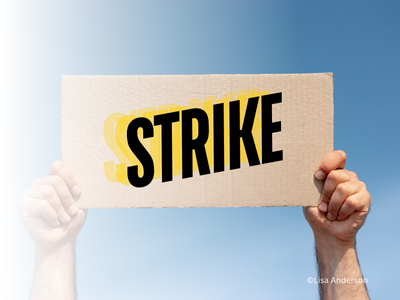Disruptions Ramp Up: Strikes, Strikes & Potential Strikes
Unfortunately, there has been a plethora of strikes, potential strikes and disruptions in the last few years. In fact, the threat of strikes has made its way through the supply chain. After almost stopping the railroads which would have been a $2 billion per day economic impact, even significant threats of strike can seem like pocket change.
Other noteworthy strikes or work stoppages that pop to mind include the UAW strike which severely impacting the automobile industry, the Hollywood writers and actors strike which impacted related supply chains, and the Canadian railroad and work stoppage on the U.S. Canadian border. According to the Bureau of Labor Statistics, major strike activity increased by 280%.
To top off matters, Boeing machinists went on strike. The union has asked for a 40% pay raise. Of course, it is a challenge as inflation remains high with threats of stagflation looking more likely, yet Boeing must continue to produce planes especially after the series of quality issues. To read more about the impacts on the aerospace industry, read our article addressing the topic or listen to our interview with Bloomberg.
Potential strikes can have significant impacts on the supply chain. The West Coast ports were threatening strikes which partially caused beneficial cargo owners to transition additional freight to the East Coast and Gulf Coast ports. Companies have figured out that they cannot be dependent on one source and negatively impacted by strikes.
Thus, companies are proactively evaluating options for the potential East Coast and Gulf Coast port strike. The International Longshoremen’s Union is demanding significantly higher wages and a total ban on the automation of cranes, gates and container movements that are used in the loading or loading of freight. Time is running short with the two sides remaining far apart. A strike at these ports will significantly impact the global logistics and goods movement sectors (as these ports handle 55% of the U.S. volume) which would impact businesses across the country – and world. On the other hand, the U.S. ports are some of the least automated (non-competitive) in the world. Automation will leave manual in the dust. Prepare for disruption
Prepare to Thrive: Create a Resilient Supply Chain
Our best clients are preparing to thrive during these volatile times by creating a resilient supply chain. Although there are several strategies to create a resilient and powerful supply chain, a few that pop to mind include:
- SIOP (Sales Inventory Operations Planning): By rolling out a sales forecasting process to better predict future demand and recalibrating the supply plans to ensure the successful fulfillment of the sales plans at the highest profit margin and lowest inventory levels. To learn more about how to roll out the process, read our book, SIOP: Creating Predictable Revenue and EBITDA Growth.
- Planning & Inventory Optimization: Our best clients are upgrading processes, better utilizing ERP and advanced planning and forecasting tools, redesigning their networks, recalculating inventory factors, and rolling out upgraded inventory planning techniques to ensure the “right” inventory is in the “right” place at the “right” time at the “right” cost to maximize service, support sales growth, increase profitability and accelerate cash flow.
- Automation & Digitization: Another differentiator of our most successful clients are those that are investing wisely to automate and digitize their end-to-end supply chain so that they can increase flexibility, visibility, and responsiveness while ensuring the lowest cost and successfully serving their customers’ needs. For example, an aerospace manufacturer rolled out artificial intelligence (AI), automation, robotics, and 3D printing/ additive manufacturing to allow them to scale up or down quickly while reducing cost and inventory levels.
- Retaining Top Talent: Our best clients are valuing and hoarding high-skilled employees, providing opportunities for skill development, giving them access to mentors who have “been there and done that”, empowering them to test new ideas within reasonable guidelines, providing training and development opportunities (including cross-training), and rewarding failure while automating non-skilled positions. The rest are focused on cost cutting and aren’t paying attention to their most valuable scarce asset.
- Rethinking sources of supply: As a part of the SIOP process, the best executives are rethinking their sources of supply. They are evaluating backup sources of supply, making sure their backup sources are not “in name only”, expanding their sources of supply for key items, reshoring and investing in what’s core to success, nearshoring what is less core to success if there is a high labor component, evaluating risk, reallocating production, reconfiguring distribution networks, etc.
There are several more strategies to create a resilient supply chain and craft tomorrow’s supply chain today. Get a complimentary download of our special report to gain insights into the most successful strategies and gain tips for success.
If you are interested in reading more on this topic:
Production & Labor Scheduling Case Study to Maximize Productivity



